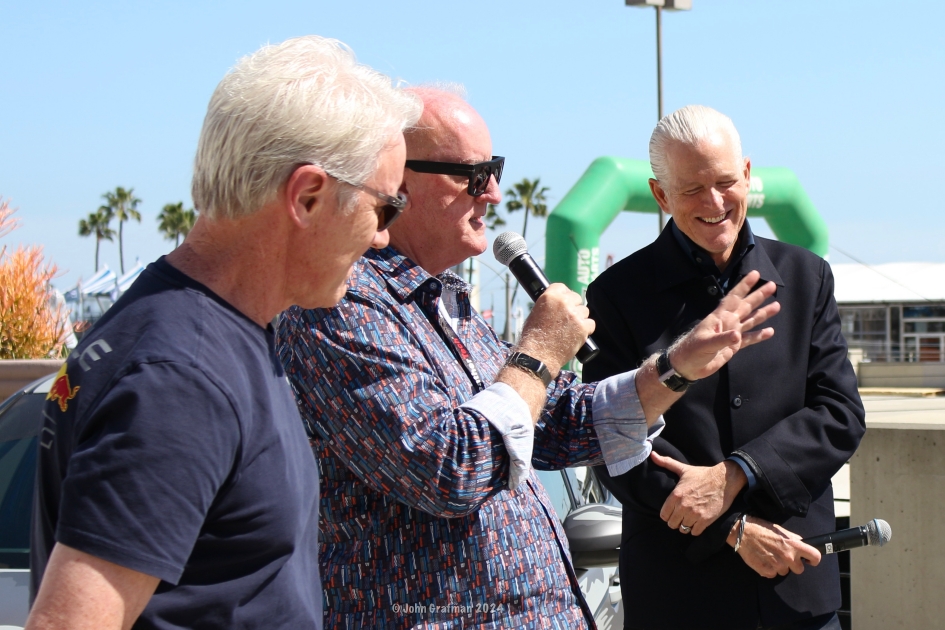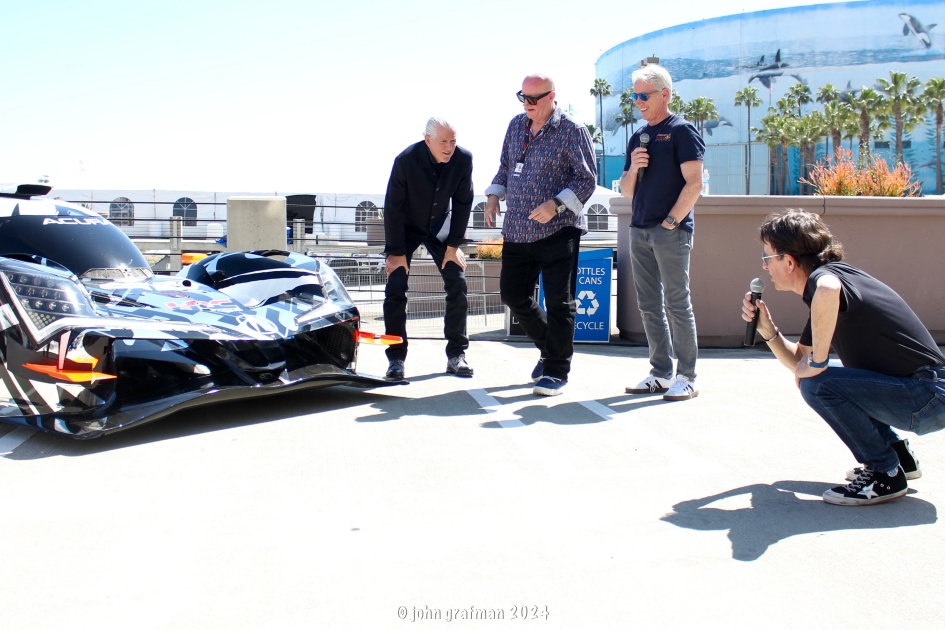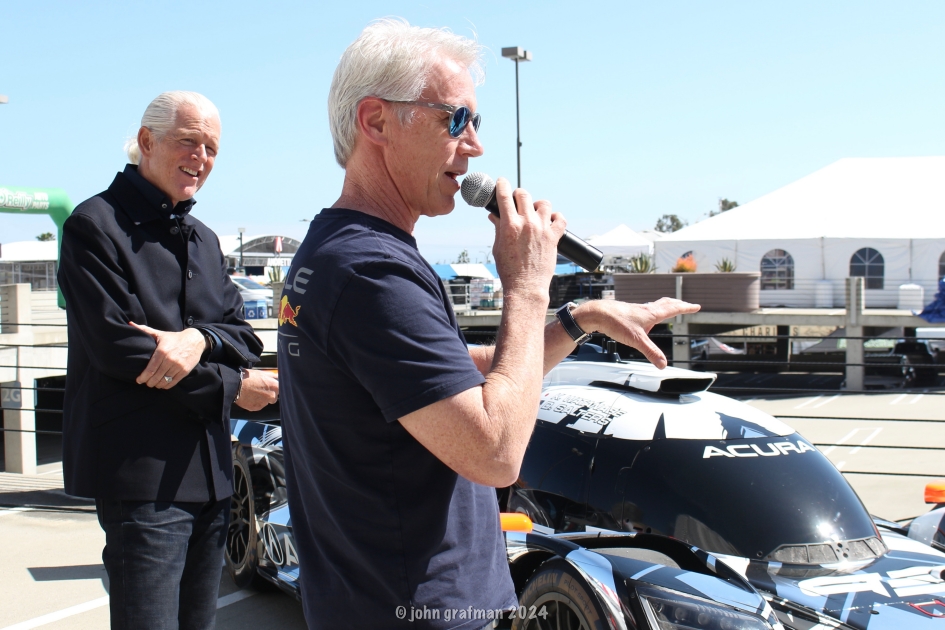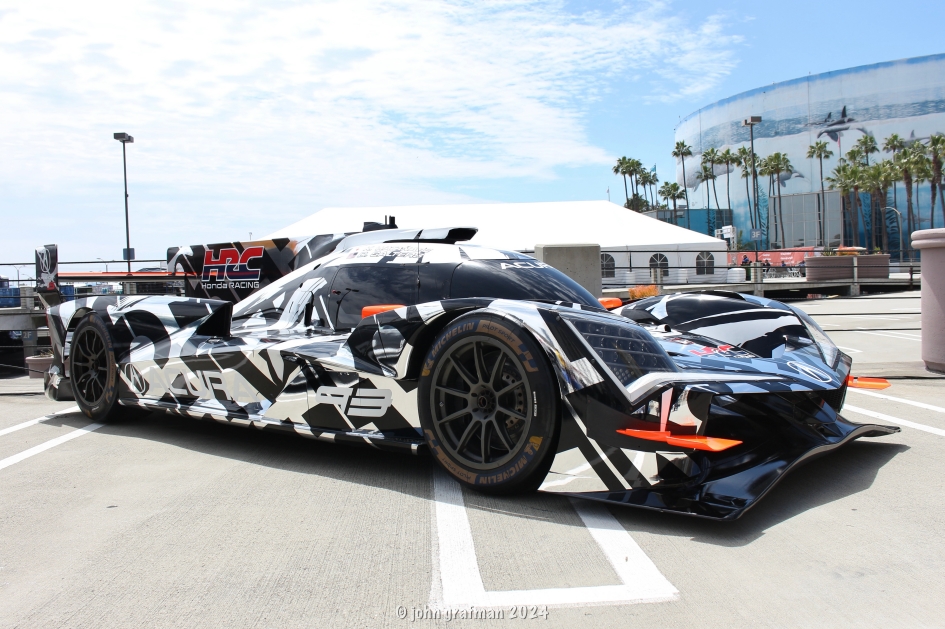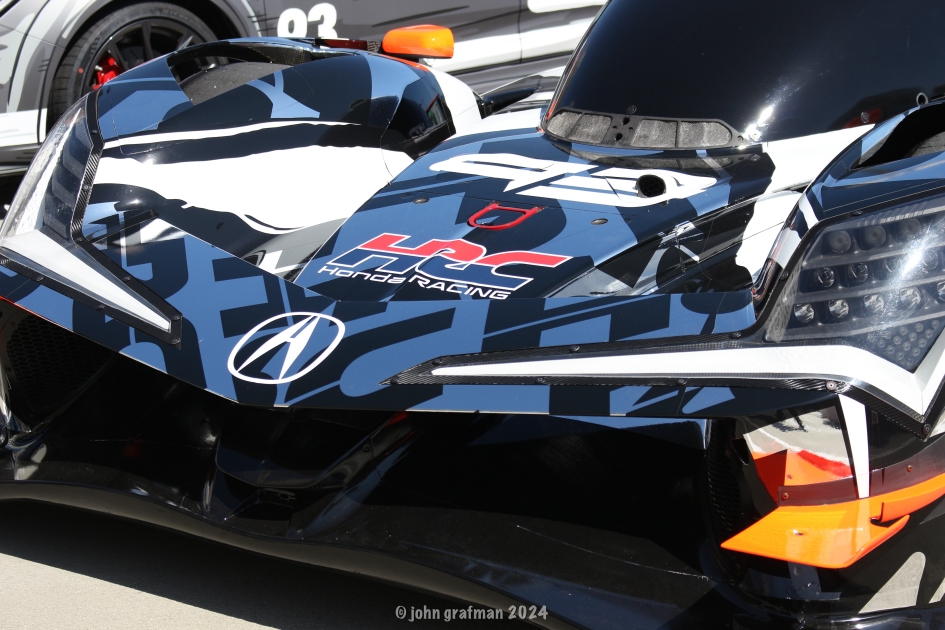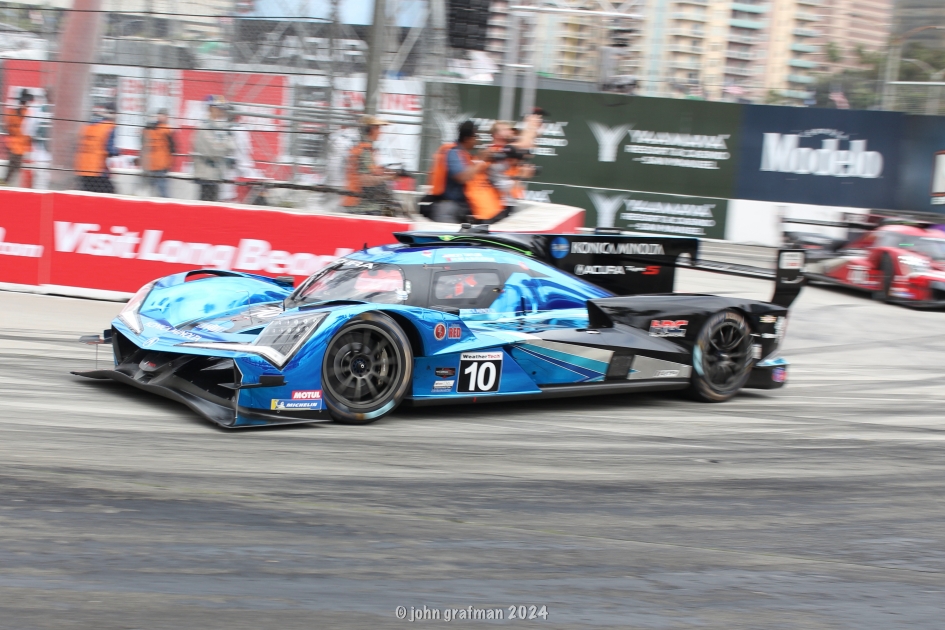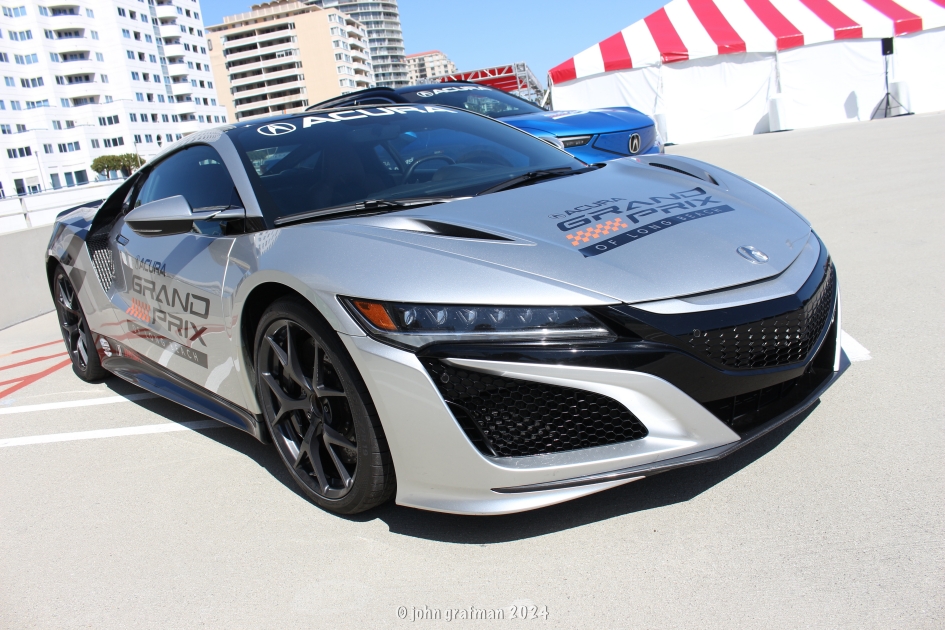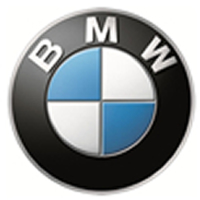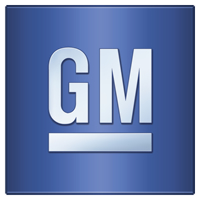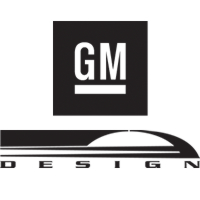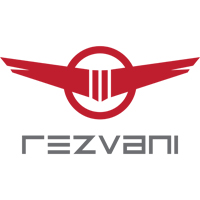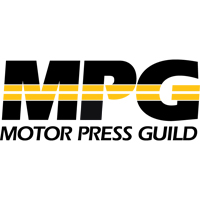Race cars blaze around tracks from Le Mans to Long Beach and leave an undeniable impression when it comes to speed. Engineering deserves recognition for incredible achievements upon those courses. Of course, there’s more to the story. The shape and design of those same race cars are equally thrilling. Like engineering, the visuals can carry-over into production cars, and production cars can also influence the racers. AutoDesignO understands this and connected the dots at the 2024 Acura Grand Prix of Long Beach with this presentation. Acura’s design team and the co-owner of one notable race team detailed the development of the ARX-06 with moderation provided by the talented Eric Noble of The CARLAB.
The Driven Design media-only event unfolded trackside on April 18th. This is the first part of an hour-long discussion that presented not just the dedication and professionalism found in the design world, but also the highly skilled, good natured, and frequently humorous individuals involved in the process.
Images © John Grafman except where noted
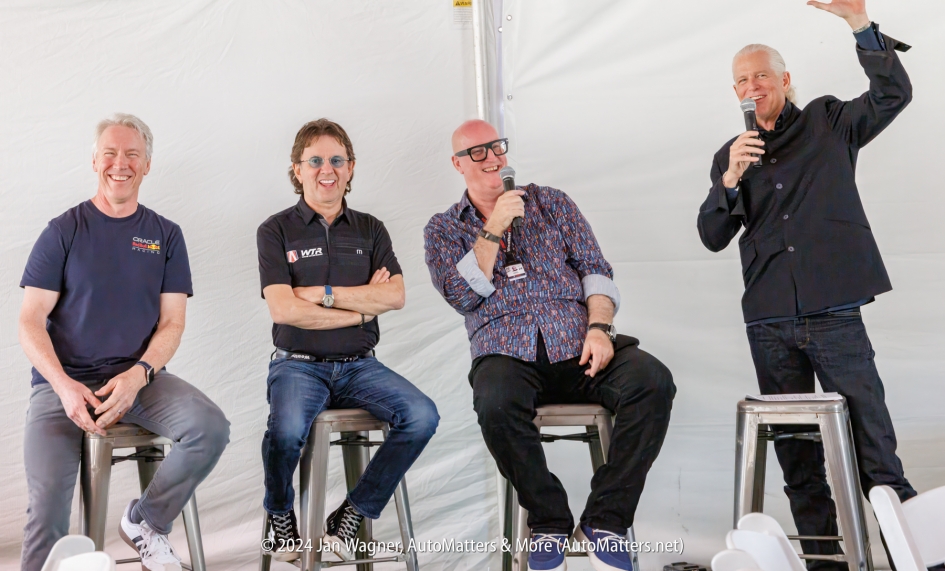
(L-R) Bill Yex, Wayne Taylor, Dave Marek, Eric Noble. photograph © Jan Wagner 2024 / AutoMatters & More
THE PRELUDE
Eric Noble: We want to inspire. There’s a race team here, right, that has things that they like to communicate. Honda is here through Honda Performance (formerly HPD) or the new acronym, Honda Racing Corporation (HRC). We want to inspire you to think about them in some ways. And most importantly, we want to inspire you to think certain ways about Acura that hopefully are very consistent with what’s happening here at the at the Long Beach (Long Beach Grand Prix, aka Acura Grand Prix of Long Beach, or AGPLB).
We’ve got Bill Yex. Can you tell us what your official title is, and then when that doesn’t make sense, tell us what you do.
Bill Yex: My name is Bill Yex, I’m Special Projects Lead for Acura and Honda Design. I was Assistant Project Lead on this project. The large Project Lead was Mark Crawford who worked for HRC. I basically handled all the logistics between design and building the cars stylistically. So, many other things I’ve done, the Honda Indycar powered CR-V Beast- its here this weekend – I was lead on that. The crazy Hoonigan Indycar powered IndyTruck lead as well. Before doing special projects, I was a clay sculptor and worked with Dave on a lot of cars. A lot of cars on the road, I was responsible for the shape of the car. Yeah, this project was amazing. This was a career project for me.” – Yex
Eric Noble: Also, an ArtCenter transportation design department alumni. A long time ago he graduated.
Bill Yex: Bachelor Science in Transportation.
Eric Noble: Wayne, if you thought he was an escapee from the South African cast of Beatlemania, that is not correct. He runs a race team.
Wayne Taylor: That’s right, yeah. My name is Wayne Taylor and I do run the two-car program for Acura (Co-Owner of WTRAndretti). My background is, I’ve raced since I was 15 years old, and driving race cars was my vision. That’s what I wanted to do for the rest of my life. I never believed that I would be a team owner, because that just looked like a lot of work, and it looked like it needed a lot of money. I didn’t have the money, but I got thrown into it. And so, I sit here today after 18 years as a team owner running the second program with Acura. We’ve had a great two years, although our program started the year before the current hybrid cars. This is our second year and we’ve had 1st and 2nd at Daytona, I think, twice. We won the North American Endurance Championship. And we are currently tied for the points lead with Penske and the Porsche.
Eric Noble: And this is Dave, Dave Marek.
Dave Marek: Hi everybody. I’m Dave! I’m Acura Executive Design Director. What does that mean? I’m responsible for the production of whatever you see inside, outside, CMF. I’m also working with Bill on all the special projects. It’s kind of like, the special projects you’re doing, what does that mean? If you take the Beast, for example, Bill we’re gonna build this car with an IndyCar motor in it, and in my duties, it’s kind of like, well I’ll do it last time. So, we do a lot of that, and I think that you’ll see when we were doing the ARX, and even with Wayne, that is not low key, it’s actually high-energy. But the actual joy of working on it is very Honda. It’s like, just do whatever you do, and do it on your own. And we did.
“I think you’re gonna ask about COVID, it was very COVID. We were in the studio every day, just like it would be like if your kids got to go to a design school, and nobody’s there. They could run, got to touch, do whatever they wanted to do – that’s what we did. It was literally this playground for us because there was really no agenda other than we had to get the car done. And so, there was no interference, no meetings, no Zoom, no nothing. We just we’re working on it all the time and it’s like the greatest experience. We ended up having a car that wanted first time out.
Eric Noble: How long you been at Honda?
Dave Marek: A long time. This year is 37 years.
Eric Noble: And also, ArtCenter alumni?
Dave Marek: Art Center faculty, ArtCenter Full Circle Board Center.
Eric Noble: I’m Eric Noble and with The CARLAB. Our director (Maeva Ribas) is also here today. We help manufacturers and suppliers plan and design new vehicles and got to work with, not with Wayne but with these other two on what became the 10th generation Civic. We were lucky enough to be part of that program.
ACURA TAKES RACING DEVELOPMENT INTO THE DESIGN STUDIO
So, what I want to get into now though is, is the inception of this program. First of all, this was going to be new powertrain-wise because this class had not been hybrid before. Is that accurate? That’s correct, right? So, you get a little bit of lead from IMSA. They give you a heads up that the formula is going to change and that entails new chassis, and therefore new bodywork to go with the powertrain. What happened on this program is why we’re here today. It’s unusual because the manufacturer didn’t, Cadillac, just put graphics on the car and call it their brand. The manufacturer was involved from the beginning. And curiously, design, which sometimes in our industry gets erroneously called styling, design was involved in the car as well and that’s a very curious involvement.
Wayne Taylor: I think one of the important factors here is that because my career spans back since I’ve been in the United States, I’ve been in every single sanctioning bodies’ sports car series, and we’ve gone on from Camel GT’s to Exxon Supreme, to DPI, to Grand AM. But the neat thing that’s going on in sports car racing right now, today, is the fact that we are – insert “controlled” by the FIA, which is the same company that looks after Formula One. And then if you want to go to Le Mans, because [for] car manufacturers it’s almost a must to compete at Le Mans to get those points as a successful car builder. And that sanctioning body, the ACO, got together with IMSA and FIA and came up with this new hybrid system. And in all my career as a driver, I’ve never seen more prototypes with different car manufacturers, so there’s massive amounts of investment put into these cars.
There is a ton of time put into this design, and everything that these guys do. And then when they finish their stuff, they give us the cars, and then we have to do our jobs to get these cars to be competitive. Right now, it is as you say, it’s IMSA and its ACO. So, [as an] example, Cadillac is racing here this weekend. And there’s also a Cadillac racing in Suzuka in Japan, today. So, Cadillac runs one car in the US, one in ACO. Penske runs two cars here and two cars over there. And so, it’s now a global brand.
THE REAL WORLD VERSUS THE VIRTUAL WORLD
Eric Noble: In terms of the development of this car, Honda and Acura Design were in the kitchen. And in a kitchen that we’ve learned for the last 20 years is dominated by CFD, and CFD stands for what gentleman?
Bill Yex: Computational Fluid Dynamics. It’s basically testing the car in a virtual world, on the computer. So, it’s gotten to be a very accurate process. Back in Formula One, a couple decades ago, it wasn’t so good. But now it’s like very accurate. Like we did a test, we did a full-size test of the nose of the car early on, and it correlated perfectly with the CFD that we did in the computer.
Eric Noble: So therefore, instead of some old, 70-year-old male coming in and making the design decision about what goes forward or not, which is what happens at car companies, right, some guy who doesn’t even own his own car anymore here comes in and approves it, right (laughs from all)? You had a different taskmaster, which was in a way aero, right? So, Dave, you had to do an Acura? Otherwise, this program doesn’t make any sense for the brand. But the person, the initials of the old-ass, male-executive that was going to sign-off on the car, we’re actually CFD, right?”
Dave Marek: Well, yeah. I think that you cut to the chase. Literally, IMSA, even when we did the 05 (ARX-05), IMSA came to us, “Can you do anything to get to get the car to look more like an Acura?” That car was, you know, there was a no-fly zone – the whole car. We were able to do the front. We did a bunch of rears on it, but ultimately you couldn’t do it from a performance standpoint, and visually they didn’t want to change stuff. So, this car, IMSA said we want to give you the freedom to design something that looks like an Acura, and so what is that? So, I think today’s discussion is, how does this relate to production cars, and does production cars relate to this. Early into the exercise, it was like, let’s have the design studio do the car. And we’ll work with HPD (HRC) aero guys.
We said, why not have the design studio do it and be involved. We thought at the time, that’s how you connected to this is (the theme of Driven Design), we could learn some aero activity from what HRC is doing with all their aero testing and actual wind testing, and we could teach them how we do aero through production car and the production car process.
I guarantee you this is the only race car that went through a studio, except maybe the Daytona – the early Shelby Daytona did all that stuff. I’m sure we were the only studio that had it in the studio and went through a regular production car program. We were doing other cars at the same time we were doing the car out there, the ZDX. We were doing the show car that led to that, the Precision EV.
And I think that it was just one of our projects that was on the schedule, Bill was working on it every day, and we’re working on the other ones every day. And other than the fact that it’s coolest race car on earth, it was just like one of our other projects. I think it’s that connection of what we knew from production cars and what you go through helped to maybe run the car more efficiently from a bodywork standpoint. But then, the HRC aero quickness was able for us to get information right away, and Bill can talk about that because that was him every night on the phone with the aero guys, with ORCA, and with HPD guys at the time.
Eric Noble: And if HPD doesn’t let you in, Bill, you have to be on the phone to them?
Dave Marek: Well, they weren’t even at work. We were at work. We had these full-size clays. Yeah, they were slacking (laughs). We were in the studio. It’s really hard to do a clay model, just so you know, virtually. Yes, it’s virtually impossible!
Eric Noble: Clay all over your keyboard (smiles)? Can you talk a little bit about the modeling process, and then Wayne, I want you to think on sort of how all of you interacted with ORCA at this point as well, because that that chassis was being developed simultaneously in France, right? Bill, back us up a little bit. Dave said this was very like a production program, so now you’re committed to that bullshit (joking and laughing). It was very much like a production program, but to those from the racing media, that may not mean anything. So, what is it that’s happening when you say you’re modeling a new vehicle in the studio?
CREATING RACE CARS LIKE PRODUCTION CARS
Bill Yex: It first starts with, we knew what our task was, right. We had to do a race car. It starts with sketches. We did lots and lots of sketches, kind of just shotgun stuff. We were trying all kinds of things like something with a cabin shape really far forward or maybe in the middle of the car, wacky fenders, just different stuff trying to see what sticks. But early on, we wanted this car to look bad-ass. We wanted it to look weapon-like, because when people saw it, we wanted them to think – wow, this thing looks not evil… One of our sayings was, ‘mean and nasty’. We wanted it to look very purposeful and something that people would remember, and also not be afraid of, but maybe intimidated by. I think some of the other cars that were done for the GTP class don’t have that. I think the Acura does have that, so I think it’s definitely a plus.
Eric Noble: And that’s a brand issue?
Bill Yex: Because we’re a performance brand, we wanted it to look performance. To be performance sometimes that’s maybe aggressive looking. So, we wanted the car to look aggressive, we wanted it to look fast.
Eric Noble: It got said earlier that Acura is a premium brand, but the word luxury really isn’t allowed. In fact, no one from your Torrance campus would ever even utter the word luxury, would they, at least in front of the microphone?
Bill Yex: No, which is incredible.
Eric Noble: That’s right, Precision Crafted Performance.
Bill Yex: Acura went through some dark times where they were trying to do some stuff. Me and Dave came back to this when they were looking for, kind of what would we do, several years back, it’s kind of like Precision Crafted Performance. I mean it was fantastic when it was established. So, we went back to it.
Eric Noble: That was the original tagline for the brand. Acura is the performance division of Honda, OK.
Bill Yex: We looked at encompassing that. Early on, we wanted it to feel amazing.
Eric Noble: How do you do that and still give Wayne a car that his kids can win in?
Bill Yex: Well, part of the process was, we have an aerodynamic window that we had to stay inside of.
Eric Noble: But what does that mean?
RULES, REGULATIONS, AND RACING
Bill Yex: Well, it was a box that that IMSA and WEC established for us to keep inside of. The car couldn’t be too aerodynamic. Formula One doesn’t really have that have that limitation. But for this, the car couldn’t be too slick. It enabled us to make shapes on the car that weren’t completely race car shapes, like aerodynamic. It allowed us some freedom to style the car.
There’s still a dimension box that we had to put the car inside of, which is very similar to production cars. You usually start with some dimensions that will fit occupants. This is very similar to that attitude, the same thing. We have to fit the driver, we have to fit the hybrid system, we have to fit the power plant. IMSA creates a box that the car has to fit in and then we design inside that box.
Eric Noble: And if I can be so blunt, IMSA is very much, more than a camel’s nose under the tent. IMSA monitors these cars all the time, right?
Bill Yex: Yeah!
Eric Noble: Does that give you more freedom to the extent that IMSA is gonna equalize these cars in the end anyway? Can you make the aero worse, effectively a little bit, because IMSA is going to work really hard to make sure these cars are almost equal all the time on the track? I mean, in other words, if your aero was really amazing, IMSA is gonna just handicap that away from you anyway, right Dave?
Dave Marek: It was, the aero was that and we bumped it up a little bit. The aero was better than it should have been, like through a lot of iterations of front fenders, and what we call the shark close. It literally was so good that we were able to change some stuff, but it was it was really good.
Eric Noble: And that’s because what ORCA or Honda, what you what you call HPD (now HRC), had done really good aero.
Dave Marek: We had sketches and Bill started sculpting it. And we went, ‘That thing looks like a race car. That’s f’ing cool.’ And it was. We went back and forth a lot, but that initial [impression] was like, ‘I think we’re onto something’!
End of part one. To be continued…
To get the driver’s point-of-view on what exciting, follow-us!
Editor’s notes: This design discussion has been edited down to eliminate irrelevant and confusing dialogue from the article.
AutoDesignO wishes to express our sincerest gratitude to Matthew Burnam, Jake Berg, Dan Layton and Andrew Quillen from Acura PR for assistance with Driven Design and providing the ARX-06 and NSX. Additionally, we thank Chris Esslinger, Director of Communications for the AGPLB, and his team for graciously allowing the press to get a deeper dive into what makes a race car come alive. Eric Noble and Maeva Ribas from The CARLAB have gone above and beyond to continue to give a voice to this and prior programs. The appreciation is immeasurable.
A special thanks to Jan Wagner of AutoMatters.net for providing additional images, and Ed Jenks for providing audio recordings from Driven Design for transcript reference.



